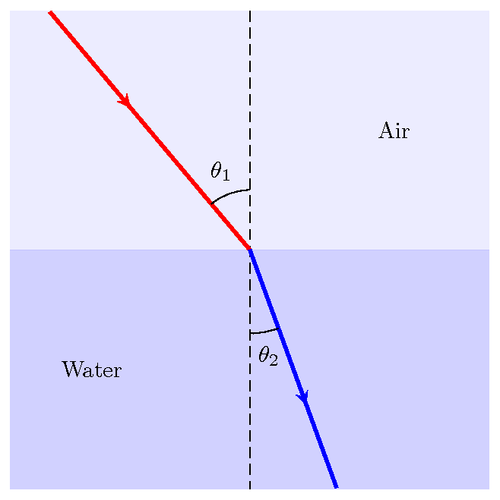When light travels from one medium to another (for instance, from light to water), its speed changes, causes the rays to bend. This phenomenon, called refraction, is governed by Snell's Law, which states that the ratio of the sine of the angle of incidence to that of the angle of refraction is a constant (known as the index of refraction).

Edit and compile if you like:
% Refraction
% Author: Jimi Oke
\documentclass[11pt]{article}
\usepackage{tikz}
\usepackage[active,tightpage]{preview}
\PreviewEnvironment{tikzpicture}
\setlength\PreviewBorder{5pt}%
\usetikzlibrary{arrows,shapes,positioning}
\usetikzlibrary{decorations.markings}
\tikzstyle arrowstyle=[scale=1]
\tikzstyle directed=[postaction={decorate,decoration={markings,
mark=at position .65 with {\arrow[arrowstyle]{stealth}}}}]
\tikzstyle reverse directed=[postaction={decorate,decoration={markings,
mark=at position .65 with {\arrowreversed[arrowstyle]{stealth};}}}]
\begin{document}
\begin{tikzpicture}
% define coordinates
\coordinate (O) at (0,0) ;
\coordinate (A) at (0,4) ;
\coordinate (B) at (0,-4) ;
% media
\fill[blue!25!,opacity=.3] (-4,0) rectangle (4,4);
\fill[blue!60!,opacity=.3] (-4,0) rectangle (4,-4);
\node[right] at (2,2) {Air};
\node[left] at (-2,-2) {Water};
% axis
\draw[dash pattern=on5pt off3pt] (A) -- (B) ;
% rays
\draw[red,ultra thick,reverse directed] (O) -- (130:5.2);
\draw[blue,directed,ultra thick] (O) -- (-70:4.24);
% angles
\draw (0,1) arc (90:130:1);
\draw (0,-1.4) arc (270:290:1.4) ;
\node[] at (280:1.8) {$\theta_{2}$};
\node[] at (110:1.4) {$\theta_{1}$};
\end{tikzpicture}
\end{document} Click to download: refraction.tex • refraction.pdf
Open in Overleaf: refraction.tex


